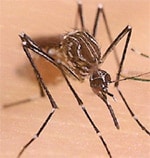
By: Kristen Kocher
Humans and worms are more alike than you may realize. According to a genetic researcher at the University of Toronto, Dr. Andrew Fraser, the worm (C. elegans) is his preferred specimen for genomic studies. “I think worms are totally cool, like humans only simpler and easier,” Fraser comments. It is important to understand that we are not only in the same phylogenetic domain (Eukarya) and kingdom (Animalia) as worms, but between us we share nearly 10,000 comparable genes. This makes worms like C. elegans an excellent vehicle for understanding human genetics and genetic disease without actually studying or experimenting on human beings.
With a genome a little less than half the size of that of humans, it is easier for geneticists to perform certain research techniques that would be very difficult to perform on humans. One such technique is known as RNA interference (RNAi), which shuts down one gene at a time and allows researchers to observe and catalogue specific gene function and possible interactions with other genes. Discovered by Andrew Fire and Craig C. Mello, RNAi is a very effective method of “gene silencing” and is found naturally in worms. Scientists have been able to harness this innate phenomenon and use it to their advantage in understanding the way similar genes between worms and humans function. Geneticists face the challenge of understanding how genes in any organism are expressed phenotypically. Phenotype is the “final outward expression” of an organism’s genetic makeup. In worms, however, it is slightly easier to observe the expression of certain genes when RNAi is occuring because of their drastically simpler genome.
Fraser suggests that his research with worms will aid in predicting “the effects of inherited mutations and to understand how multiple mutations combine to be expressed phenotypically.” This work will further help in understanding how inherited mutations cause health problems in humans. Fraser makes a point of noting that humans do not exist in a controlled environment like the worms being studied in his lab. To account for this, Fraser has decided to also isolate worms from certain natural environments exposed to different conditions, providing an interesting insight as to how certain environmental factors contribute to mutations within a population.
Dr. Fraser is conducting keystone research that will hopefully provide a foundation for other types of genomic research. At the annual AAAS conference this year, Fraser will explain his research and the use of C. elegans to provide interesting conclusions as to both individual and population genetics and genetic disease for not only humans, but numerous other species within the kingdom Animalia.
Check out the original Press Release







